Add this eBook to your basket to receive access to all 1,128 records. Our indexes include entries for the spelling greaves. In the period you have requested, we have the following 1,128 records (displaying 871 to 880): These sample scans are from the original record. You will get scans of the full pages or articles where the surname you searched for has been found. Your web browser may prevent the sample windows from opening; in this case please change your browser settings to allow pop-up windows from this site. Liquidations by Arrangement
(1883-1884)
Volume 76 of The Law Times, 'The Journal of The Law and The Lawyers', a weekly publication, runs from 3 November 1883 to 26 April 1884. Much of the journal is taken up with law reports, leading articles, &c., and the 'Solicitors' Department' contains several regular features of great interest. Lists of bankrupts, liquidations by arrangement, dividends and orders of discharge extracted from the London Gazette were published each week, and these have been indexed both for the principals and their solicitors. | Sample scan, click to enlarge

| Matrimonial Litigation
(1883-1884)
Volume 76 of The Law Times, 'The Journal of The Law and The Lawyers', a weekly publication, runs from 3 November 1883 to 26 April 1884. Much of the journal is taken up with law reports, leading articles, &c., and the 'Solicitors' Department' contains several regular features of great interest. The court lists enable us to follow the progress of cases scheduled to be heard in the high courts. Many of these cases never actually came to be heard, litigation ceasing whilst in preparation, or being resolved 'at the door of the court'. In almost all cases the parties are referred to by surname only. The lists of cases pending for trial or hearing in the Probate, Divorce, and Admiralty Division are sub-divided into those for probate and matrimonial causes. | Sample scan, click to enlarge

| Bankrupts
(1884)
In accordance with the Bankruptcy Act of 1883, notices received by the Board of Trade were gazetted in tabular form by the Inspector-General in Bankruptcy. At each stage the record gives the debtor's name, address (often including former addresses), description (i. e., occupation), the name of the court, and the sequential number of the matter in that court for the year. The tables of Receiving Orders additionally give Date of Order, Date of Petition and Date of Public Examination; notices of First Meeting give Date of Meeting, Hour and Place; Adjudications give Date of Order, Date of Petition, Name of Trustee (if appointed) and Address of Trustee; Notices of Intended Dividend give Last Day for Receiving Proofs, Name of Trustee, and Address; Notices of Dividends give Amount per Pound, When Payable, and Where Payable; Applications for Debtor's Discharge state the Day fixed for Hearing; and notices of Appointment of Trustees give the Trustee's Name, Address, and Date of Certificate of Appointment. Any one debtor would normally appear in a number of these tables as his or her case proceeded over the months. These are the notices gazetted in 1884.
| Sample scan, click to enlarge

| Boys entering Tonbridge School
(1884)
W. O. Hughes-Hughes, late Assistant-Master of Tonbridge School, prepared this edition of the school register. The Kent grammar school was founded by royal charter in 1553, but the surviving register commences with the names of 69 boys called over on Skinners' Day 1826. After that they are arranged alphabetically by quarter to 1833, and thereafter by term of entry. Each entry gives, where known: the boy's surname (in capitals) and full christian name(s); the years when at the school; father's name; year of birth; school honours; and a resume of his subsequent career. | Sample scan, click to enlarge
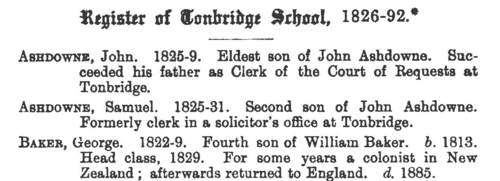
| Criminals Imprisoned
(1884)
Henry Romeike compiled this list of 800 cases, reported in the newspapers in March and April 1884, in which criminals were fined or imprisoned. The list is arranged by nature of the fine or length of sentence, divided into two groups: offences against property, and those against the person. The compilation was published by D. H. Macfarlane, M.P., to contrast the severity of sentences for theft of trivial property, as against relatively light punishments for assaults: it gives the full name of the criminal, brief details of the crime, and the name and date of the newspaper report. | Sample scan, click to enlarge
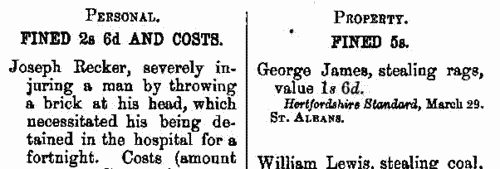
| Shorthand Writers
(1884)
Lists of members of the Phonetic Society, reports of Shorthand Writers Association and other meetings, news and advertisements, from the Phonetic Journal. | Sample scan, click to enlarge

| Unclaimed Shares of Special Gratuities for Naval Service in Egypt and the Soudan
(1882-1885)
Various gratuities were awarded to officers and men who served on board her Majesty's ships during the wars in Egypt and Soudan. The Achilles, Agincourt, Alexandria, Beacon, Bittern, Carysfort, Chester, Cockatrice, Condor, Coquette, Cygnet, Decoy, Dee, Don, Dragon, Eclipse, Euphrates, Euryalus, Falcon, Hecla, Helicon, Humber, Inconstant, Inflexible, Invincible, Iris, Malabar, Minotaur, Monarch, Mosquito, Northumberland, Orion, Orontes, Penelope, Ready, Ruby, Salamis, Seagull, Seahorse, Sultan, Superb, Supply, Tamar, Temeraire, Thalia, Tourmaline and Wye were engaged in the Egypt Operations of 1882; the Arab, Briton, Carysfort, Decoy, Dryad, Euryalus, Hecla, Humber, Jumna, Orontes, Ranger, Serapis and Sphinx in the Soudan Operations of 1884; and the Albacore, Briton, Carysfort, Condor, Coquette, Cygnet, Dolphin, Falcon, Helicon, Humber, Iris, Myrmidon, Rambler, Ranger, Sphinx, Starling, Turquoise, Tyne and Woodlark in the Soudan and Nile Operations of 1884 to 1885. Some of these gratuities remained undistributed by 1902, when this comprehensive list of the unclaimed moneys was printed. In each case the sailor's name is given first (surname, then christian name or initials); rank or rating; ship in which serving at time of capture or award; and amount of award (usually £2 or £5). | Sample scan, click to enlarge

| Boys entering Giggleswick School
(1885)
The school at Giggleswick in the West Riding of Yorkshire dates from at least 1507, but no register of the boys attending there has survived earlier than one started by the headmaster, the reverend George Style, in 1875. When the bursar, H. L. Mullins, prepared this, 'The Giggleswick School Register', printed in 1913, he was able to compile general details of some scholars from earlier years, but the concerted, reasonably complete, account starts in 1859. The details are arranged by term of entry, then alphabetically by surname and christian name. Typically each description gives full name; date of birth; name and address of father; date of leaving. Where known, Mullins then added a brief career synopsis, present address in 1913, or date of death. From 1869 onwards boarders were admitted to the school, and where it is known that a boy was a day scholar, the word (Town) is added after his name. | Sample scan, click to enlarge
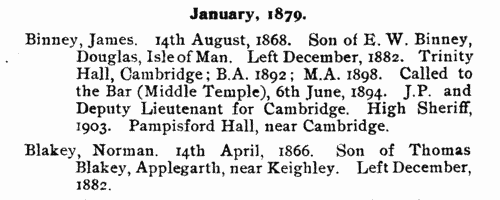
| Justices of the Peace, Buckingham
(1885)
"Return giving the Names and Professions of all Justices of the Peace in the Boroughs and Cities of England and Wales, on the 1st day of June 1885, with the Dates of their Appointment; showing which were Non-resident, or had ceased for a Year or upwards to attend the Bench." | Sample scan, click to enlarge
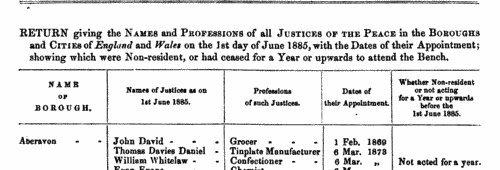
| Men-at-the-Bar
(1885)
Joseph Foster's Hand-List of Men-at-the-Bar gives a paragraph biography of men who had been called to the bar and were alive in 1885. After the full name (surname first, in capitals) there is a short statement of occupation or practice; a student at which inn of court; when called to the bar; father's name and then address; when born; if married, and, if so, wife's name (and her father's name) is often given. At the foot, in small type, is present residence, as of 1885. | Sample scan, click to enlarge
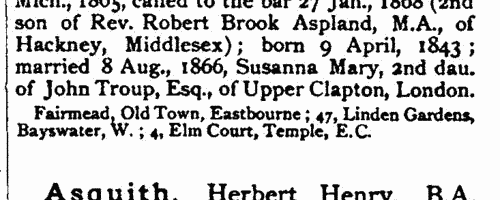
|
Research your ancestry, family history, genealogy and one-name study by direct access to original records and archives indexed by surname.
|











